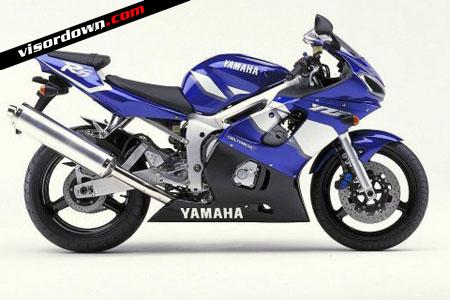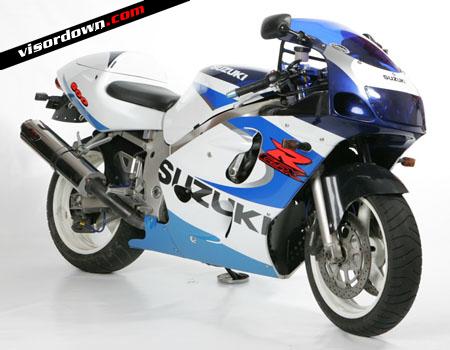Best track bikes for £2000
A must for budding trackday addicts


Hopefully you're ok but what's happened to your bike?
Lobbing your bike at a trackday can be an almighty painful experience. One minute you're having the time of your life -- the next you're sliding down the road on your arse, wishing you hadn't got quite so carried away. Fingers crossed you'll be ok but what about your bike? Even a low speed prang can write-off a modern race replica -- we all know how extortionate spare part prices have become. What's worse, most insurance companies won't be settling your repair bill. So what's the answer?
Wander around any trackday paddock and you'll see bikes that look like full-on racers -- fibreglass bodywork, no lights -- some even have slicks tucked cosily away inside a set of tyre warmers. But most of the owners aren't competitive racers, they're just ordinary people that enjoy trackdays and have invested some cash in a dedicated track bike. We reckon it's the sensible option for aspiring trackday lovers.
With the help of Darren at MCT suspension, we've chosen, what we think, are the five best track bikes for £2000. Good examples are plentiful, cheap and can keep up with more modern stuff with a few crafty modifications. Spend £1000 - £1500 on a tatty example (you're going to strip the bodywork and replace it with cheap stuff, remember) and you've a few hundred quid left to fettle the suspension. So all those damaged repairables and tarted-up ex-racebikes you've been avoiding for the last umpteen years are now fair game.
Who knows -- with some sticky race tyres and a bit of practice you could be raising a few eyebrows in the fast group.

2000 YZF-R6...capable in standard trim
Yamaha YZF-R6 2000 -- 2002
Cost new -- £6799
Cost - £1500 -- £2000
169kg and 100bhp at the rear wheel, doesn't sound like much compared to modern 600s but R6s of this vintage are more than capable of putting in some serious lap times in then right hands.
If you're used to a bigger capacity bike, you might find the low down pull on the flat side, so you'll need to keep things hammering between 9000 and 12,000rpm, which can seem almost cruel if you're not used to it. The delivery from the 37mm Keihin carbs is turbine smooth, so you won't get any nasty surprises when you're firing out of corners cranked over.
The gearbox isn't quite as sweet. Expect a hefty thunk from first to second and notchiness throughout. If the bike jumps out of gear then a rebuild's on the cards. About £1000, for a decent job.
Even the standard suspension is good enough for hard trackday use, although Darren at MCT recommends changing the fork oil and servicing the rear shock of the bike's done more than 20,000 miles. If you're unsure of the mileage then most suspension experts will give you a free quote on work that may need doing.
Stuff to check
Excessive smoke from the exhaust on start up -- worn bores or valves guides
Oil consumption -- expect to use 1 litre every 1000 miles if thrashed
Head bearings
Wheel alignment
Warped dics
Specs
Engine 16v, in-line four 599cc
Power 115bhp @ 13,000rpm
Torque 68.1ft-lbs @ 11,500rpm
Chassis aluminium twin-spar
Dry weight 169kg

Steel framed CBR...solid, dependable and yours for £900
Honda CBR600 1995 -- 1998
Cost new £6995
Cost now £1200 -- £1800
They may be over a decade old but a good steel framed CBR600 still makes a handy track bike with a few crafty modifications. And because they're cheap and plentiful you can pick up a mechanically sound but cosmetically scruffy ram-air induction CBR for around £1000, which leaves some reserves for some aftermarket special bits.
Most people won't touch these bikes now as they're deemed old hat. Even so, a well-modified example's still good enough to give a trackday enthusiast plenty to go at. So what needs doing?
A pipe, dynojet kit and air filter usually results in mid 90s bhp. The CBR's engine is a solid, powerful motor that's virtually indestructible in standard trim, although camchain tensioners can prove problematic. Listen for a ticking/rattle from midway down the engine block. They cost around £50 to replace.
An Ohlins rear shock and front forks revalve and respring sorts the suspension. This will cost around £400. The standard calipers are good enough - race pads improve matters but will eventually warp discs. Rear sets will improve ground clearance -- much needed if you're pushing hard on sticky tyres.
Spares, including trick bits, can found on places like ebay. Steel framed CBR parts are in abundance, so a spare set of wheels for wets won't cost the earth and other spare parts are on tap at cheap prices.
According to Darren, who used to race a steelie, sourcing a decent ex-racer is a good idea, as all the work's already been done. Just make sure you're not buying a whole load of trouble. Highly-tuned engines are best avoided.
Stuff to check
Camchain rattles
Warped discs
Wheel alignment
Split frame paint -- twisted chassis
Specs
Engine 16v, in-line four 599cc
Power 100bhp @ 12,000rpm
Torque 46.3ft-lbs @ 10,000rpm
Chassis Steel spine
Dry weight 185kg

GSX-R600 SRAD focussed for the road -- great for the track
Suzuki GSX-R600 SRAD 1997 -- 2000
Cost new £6999
Cost now £1200 - £2000
Cramped, revvy and twitchy handling -- many riders found this model GSX-R too focussed for road use. These attributes, however, make the SRAD a brilliant track bike pretty much straight from the off. A set of sticky tyres, some race pads and a suspension overhaul transform even fairly tired SRADs into blinding trackday weapons.
At the heart of the SRAD is Suzuki's 16v engine, which will produce close to 90 bhp at the rear in standard trim and around 100 with a little help from a decent pipe and a rolling road tune up. Like most 600's, the motor needs beasting for best results, which isn't a problem, as the GSX-R feels better the harder it's revved. It's a strong unit too, with virtually no mechanical gremlins, although it's wise to replace the camchain as soon as any rattles develop -- usually every 15,000 -- 20,000 miles. You'll find little fault with the 600s gearbox, as it's typical slick Suzuki stuff and one of the best bits of the bike.
Darren at MCT Suspension says the 600's a better choice over the 750 as the chassis struggles coping with the bigger bike's extra power. 'A good rider can go just as quickly on a well-sorted 600. Standard bikes handles really with some minor tweaking of the adjusters. But if you want to get the best out of it then a suspension overhaul's the way forward. Budget on spending about £400.
Stuff to check
Wheel alignment
Camchain rattles
Head bearings
Cracks in aluminium frame/subframe
Specs
Engine 16v, in-line four 600cc
Power 110bhp @ 11,800rpm
Torque 50ft-lbs @ 10,000rpm
Chassis Aluminium beam
Dry weight 174kg

Hornet...easy to work on, reliable, massive fun
Honda Hornet 600 1998 - 2003
Cost new £4995
Cost now £900 - £1800
You've only got to watch a round of the Hornet Cup (the Honda has its own one-make race series) to see these little bikes are much more than just a snazzy commuter.
The Hornet first appeared in 1998, as an alternative to the fairly drab nakeds on offer at the time. It uses the same engine as a CBR600 from the same era, only lightly retuned for better midrange and less top end, so you're assured of a proven engine and running gear.
Hornet Cup racers do little to their bikes to make them competitive. Most fit an end can, upgrade the forks and fit an aftermarket shock. Rear sets and uprated pads are also common additions, as standard Hornets were fitted with novice friendly pads.
Pre-2000 Hornets have a 16-inch front wheel, which many change to the now standard 17-incher. This improves stability, as well as giving the rider a greater tyre choice.
The lack of fairing makes the Honda much easier to work on than a fully faired bike, but the lack of plastics mean crash bungs are a must, as the engine casings can wear through if the bike's dropped at speed.
Ex-race bikes are a good buy if they've been modified well and not been crashed heavily. Check wheel alignment for a twisted chassis.
Stuff to check
Wheel alignment
Camchain rattles
Tired suspension
Front wheel size
Specs
Engine 16v, in-line four 599cc
Power 96bhp @ 12,000rpm
Torque 47ft-lbs @ 10,000rpm
Chassis Steel spine
Dry weight 179kg

The original R1...some say it's still the best
Yamaha YZF-R1 1998-1999
Cost new £9199
Cost now £1500 - £2000
When the R1 appeared in 1998 none of us could quite believe it. A small as a 600, as powerful as anything else on the road and handling to rival a GP bike from only a couple of years ago. We love 'em.
Finding an early R1 for £1500 to £2000 means you're going to end up with either a crash damaged or tatty example. But don't let that put you off, because once the bike's been given a new set of race plastics and a suspension overhaul (most will need it) you're going to be piloting a seriously capable track bike.
Darren at MCT says the R1's weak point is the front suspension. The front end's transformed once the forks have been revalved, and freshening the rear shock really helps rear end feel. The R1's hard on head bearings, too.
At around 135bhp at the rear wheel the motor's powerful enough, although there have been reports of gear selection problems between 1st and 2nd, so try the box thoroughly before buying. An exhaust system and carb kit usually sniffs out another 6-8bhp, although we'd recommend spending any spare dosh on suspension, as the thing's fast enough already. Finally, R1s do burn oil, so expect around a litre every 1000 miles if you're riding hard.
Stuff to check
Gear selection
Head bearings
Wheel alignment
Oil level
Suspension
Specs
Engine 20v, in-line four 998cc
Power 150bhp @ 10,000rpm
Torque 80ft-lbs @ 8600rpm
Chassis aluminium deltabox
Dry weight 177kg

It may not look much but this prang cost over £1000
Optional extras
You don't HAVE to spend extra cash on your bike. Many riders buy an old sportsbike, like the ones we've listed here, and just have fun. But if you want to improve things, and reduce the crash damage cost, then you may want to consider investing in the following and remember there's always a market for the standard stuff you'll take off the bike.
£400 -- total suspension overhaul
£350 -- aftermarket bodywork
£200 -- track tyres
£100 -- crash bung kit
£200 -- rear sets
All of the above is stuff we've found from talking to people in the know. It's the machines we think are the best value track bikes for the money -- you may think others should have been included -- so if you do let's hear about it!
Useful links

